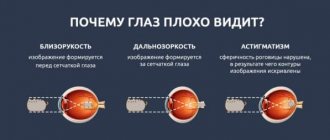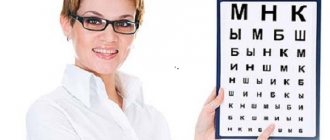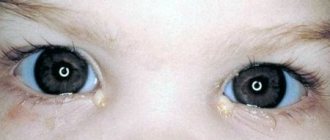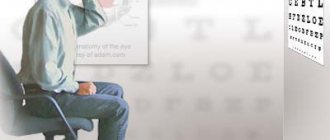How to expand your field of vision for reading. Why do you need to expand your field of view?
Peripheral vision does not allow one to determine the exact shapes and shades of objects - a person sees everything in general terms. The farther the objects in the field of view are from the point at which the gaze is focused (in our example, this is an oak tree), the blurrier their boundaries are. Thus, the visual system forms a priority point of view. The brain first receives information about those objects that are located at this point and closest to it. If the brain “read” information about all objects present in the field of vision to the same extent, this would put too much strain on the conscious and subconscious.
The field of view of peripheral vision and its quality are variable values. They can be significantly increased if you deliberately train your peripheral vision. The benefits that its development provides are undeniable. “Pumping up” peripheral vision allows you to expand the scope of your vision, which affects the amount of information entering the brain during one gaze fixation.
Peripheral vision angle
First of all, it will be useful to schoolchildren, students, and anyone who, by occupation, deals with the textual presentation of information. The so-called speed reading technique - a significant increase in the volume of text processing using special methods of information perception. A person who has mastered speed reading is able to read and, importantly, absorb up to 500 words per minute (the reading speed of the average person is a maximum of 180 words). The essence of the technique is to reduce the number of fixations (“captures” of glances on one line of text). A person who is not trained in speed reading sees and perceives only those words that are in the middle of the line. The rest are in the “dark zone”, and another “capture” is needed to perceive them. Speed reading allows you to reduce the number of grasps to a minimum - by focusing attention on the center of the line, the reader sees and perceives all the words in it.
Peripheral vision helps in developing speed reading techniques
Developed peripheral vision can serve well outside the area of texts, allowing you to better navigate the surrounding space. Thus, Shaolin martial arts masters have honed it to the maximum.
Tibetan technique for developing peripheral vision
Other names for this technique are astral and “clear vision method.” With the help of basic exercises that are easy to perform both at home and at work, you can achieve significant success in the development of peripheral vision. The result can be assessed after a month of regular training. The main tool of the Tibetan clairvoyance technique is an ordinary pencil. The training scheme remains unchanged, all that remains is to observe how much clearer and sharper the lateral vision becomes.
Tibetan technique for developing peripheral vision
- Take a pencil in each hand and, holding them vertically, fold them together. Pencils should be at eye level at a distance of 30 cm from the face. Focus your gaze on something behind them. Pencils should be on the periphery of vision and at the beginning of training their outlines will be blurry.
- Slowly move the pencils away from each other, spreading your arms out to the sides at the same level. Increase the distance until the pencils are on the right and left borders of your field of view.
- Slowly bring your hands together again until the pencils are in the starting position. Don’t try to do it faster; slowness is the key to the effectiveness of this particular workout. During all manipulations, continue to look at the same object as at the beginning of the exercise; it is very important not to shift the focus to pencils or hands. Repeat mixing and spreading at least 10 times.
- Return the pencils to their original position. Slowly lower one hand with a pencil down, and lift the other up until they reach the upper and lower boundaries of the viewing sector. Vision, as in the previous case, focuses on an object in the distance. Repeat at least 10 times.
- From the starting position, move your right hand with a pencil diagonally up, your left hand down until they reach the boundaries of your vision. After 10 repetitions, change direction - the left hand moves up, the right hand down.
- The last exercise is to return the pencils to their original position and, without moving them, mentally enclose them in a circle. Outline this imaginary circle with your gaze, first clockwise, then in the opposite direction. Repeat at least 10 times. Remember that your gaze should not focus on the pencils!
How to identify violations
The main function of this category of review is to provide coordination and orientation in space. Factors that influence disorders: injuries to the visual organs, diseases of the brain and blood vessels. This may cause damage to one or both eyes. It all depends on the degree and nature of the lesion.
Problems with such vision in most cases arise against the background of ophthalmological diseases. These include: glaucoma, increased intraocular pressure. This can cause damage to the optic nerve. Initially, minor prolapses are diagnosed in the periphery. If there is no drug therapy, then a narrowing of the field view is observed. This process is irreversible. Advanced and severe stages lead to atrophy of lateral vision.
The causes of mechanical damage to the cornea are hidden in the influence of such factors: a rapid increase or decrease in pressure, excessive stress, systematic diseases, head injuries and bruises. The presence of defects can cause damage to the optic nerves. Against this background, a violation of lateral vision develops. Therefore, if suspicious symptoms develop, you should consult a doctor. Otherwise, the consequences may be irreversible.
If local blood circulation in the organs of vision and brain is disrupted, such a pathology can occur. The presence of neoplasms of various types also negatively affects lateral vision. Brain injuries can negatively affect your vision. In most cases, such defects have a favorable prognosis if you consult a doctor in a timely manner. If there is a lack of lateral visibility, the person will not be able to lead a normal lifestyle. Age-related changes do not have a significant effect.
How to expand your field of vision. Field of view during speed reading
Hello, dear readers of the blog ""!
We have already discussed two of the three main physiological limiters of reading speed in previous articles – and here.
Today we’ll look at the third one – the field of view.
Let's look at the movement of the eye along a line during normal reading.
Movement – fixation – movement.
A few important points:
1. We can see only when our eyes are motionless. When they move, we do not perceive incoming information. It's like a camera - it captures information only at the moment of clicking.
2. We perceive text only within the field of view.
3. The eyes are not responsible for recognizing information. We perceive information solely thanks to our ability to think. The eyes have nothing to do with it.
*****
The physiological process is as follows: the eye captured what came into the field of vision - converted it into an electrical impulse - transmitted the impulse to the brain - the brain processed the signal.
Therefore, SEEING and READING are not the same thing. You shouldn't rely on photographic memory. You can, of course, “photograph” an entire page, but how can you highlight the meaning?
Eye movements when reading
Scientists obtained information about the nature of eye movements during reading after conducting experiments with a device that recorded eye movements.
The following picture shows the eye movements when reading 6 lines. Small dots are 6.8 ms time stamps, large dots are fixations.
After the jump occurs, the eye goes into a state of fixation, during which the actual perception of the object occurs. The eyes are in this state 90 - 95% of the entire observation time.
Fixation is a motionless state of the eyes during which word recognition occurs.
“The eyes stop at various parts of the text. The exact mechanism of this has not yet been elucidated by scientists. The eyes may stop not on a specific word, but between words. However, we do not realize this. From our subjective point of view, we perceive a continuous text. The brain actually receives information in small pieces, but then puts it together." I. Golovleva. "Learning to read quickly."
Experiments have shown that the reader makes 10-15 fixations on a line, moving his eyes in jumps, and then moves on to the next line. On average, the eyes stop for fixation for ¼ second.
This is what the eye movement will look like when reading the text “the gardener met the cook’s daughter, who went to school.”
As our reading skills improve, the number of fixations and regressions decreases, as can be clearly seen in the following table.
Dynamics of the number of fixations and regressions (from the book by O.A. Kuznetsov and L.N. Khromov “Fast Reading Technique”).
The duration of fixations from a certain moment of training remains at the level of 0.24 seconds. Other experiments show that this duration varies little regardless of reading skill.
Micromovements and fixations are the nature of our vision, so it is impossible to change this mechanism. But... you can optimize it by reducing the number of commits.
This is what the process of learning speed reading skills might look like over time.
An important conclusion: the fewer stops, the higher the reading speed.
Fields of vision when reading
When the gaze moves along the lines of text, the greatest visual acuity and completeness of perception occurs only in the central zone of the retina, the so-called zone of clear vision. Everything that lies outside this zone, on the periphery, is seen as if in a fog.
When reading, we can recognize on average 4-5 letters to the left of the fixation point and 8-11 to the right with normal font sizes.
The different physiological zones of vision are shown in the figure below.
We are not able to change physiological zones (for each person this is a constant value), but it is possible to use peripheral vision more effectively.
This will increase the width of the field of view.
What this means is that the volume of perceived information will expand in one fixation, due to peripheral vision, and the ability to guess the content of information from vague forms will increase.
Let's define some concepts.
The field of view is the breadth of information coverage during one fixation of the eye.
The horizontal reading field is a line segment perceived in one fixation.
The vertical reading field is a piece of text perceived in one fixation.
In practice, the vertical field of view is between half and 2/3 of the horizontal distance. It has been determined that in one glance we can see from one to five lines. From here, vertical reading is quite possible.
Those who have mastered the skills of fast reading hardly move their eyes horizontally from left to right. Their eyes move primarily in a zigzag pattern vertically from top to bottom. We will talk about eye movement methods in the next article.
Exercises to expand your field of vision
Training aimed at increasing the visual field includes exercises with Schulte tables, pyramids of numbers, etc.
In this article I do not dwell in detail on the exercises; if desired, they can easily be found in any literature on speed reading. I’d rather dwell on more important points—principles.
Exercises will be more beneficial if you understand what they are aimed at. After all, training with tables and pyramids is not an end in itself. The goal is to help the brain change the program for perceiving text, so that the largest amount of semantic information is received per unit of time.
After all, expanding the visual field in itself may not affect reading speed, even if we see many more words per fixation. The psychological side is important here.
All these trainings are purely psychological in nature. Since this does not change the very nature of the work of the eyes, the efficiency of vision does not increase, but the mental reaction to the visual image is sharpened and accelerated.
Reading as a synthesis of physical and mental activity
Let us remember that reading is a psychophysiological act - a synthesis of physical and mental activity. The work of both the eye and the brain is important here. Expanding the field of vision can only be achieved by combining the efforts of the eye and brain. It is the brain that obliges the eyes to see wider and more.
The capabilities of the brain exceed the capabilities of the eyes when reading; it can process 10 to 15 operations per second. This amount of information does not enter the brain even at the highest reading speed. Therefore, it is important that the eye captures only meaningful information.
We know that many texts are redundant. There are words that convey the main meaning, but there are also words that are used for constructive and stylistic purposes - to organize the text.
Structural linguistics claims that in socio-political, popular science styles, significant information is contained in a small part of the text - 25-30%.
The brain is very selective about various information and can quickly detect what is essential in a text. Having encountered this essential thing, he will command his eyes to run precisely over these lines, these words. Those. the brain both comprehends and at the same time directs the eyes to the necessary information.
Let's not forget about the brain's ability to anticipate, i.e. foresight. We have already talked about this quality in one of the articles. It extends not only to words, but also to large passages. We predict the future course and, accordingly, the eyes are already ready to look for this important information, simultaneously excluding the secondary.
Important note: A wide field of view significantly reduces the time it takes to search for informative text fragments.
*****
I think it has become more clear why to increase the field of view.
Not just to see more on the line, but rather to help the brain quickly highlight important information. We are, as it were, pumping more data into it, which is easier for him to navigate and, having highlighted the main thing, more effectively manage the process of vision in the further search for this main thing. This is such a vicious cycle.
Here we will finish with the physiological aspects of speed reading and in the following articles we will consider strategic and tactical techniques that increase speed, understanding and memorization of what is read.
Angle of view and speed reading
A person has the following vision characteristics:
It is better not to think at all about finding any truths than to do it without any method (Descartes)
1. By area of coverage:
- The area of best vision is 1.5 degrees.
- Clear vision zone 15 degrees.
- Maximum vision area 35 degrees.
2. By type of eye movement:
- Drift – slow eye movements.
- Fast jumps.
3. By the nature of eye movement:
- When reading, 90% of the time the gaze is motionless,
- For 10% of the time the eye makes jumps.
When examining an object, a person’s eyes make jerky movements along its contour with a frequency of 2-5 times per second. During the reading process, jerky movements occur 3-4 times per second in both a fast and a slow reader. The difference between people lies in the amount of information perceived at the moment of fixation of the eye. Text perception occurs only during eye fixations. Long pauses are caused by unfamiliar words or typos in the text. To speed up reading, it is necessary to expand the coverage angle of the text and increase the recognition of the text.
Text recognition is trained by constant reading. Gradually, consciousness forms a database of words, terms and verbal cliches. By applying accumulated experience, a person spends less time recognizing words in the text.
Online flash trainings for mastering speed reading skills
| Expanding the angle of view | Shuffled letters in words perceive the text in blocks | Schulte table | Torn text |
| Count the numbers | diagonal reading training | Schulte table | Reading without gaps between words |
| Reading without vowels | Deconcentration | Rotating text | Schulte table |
Reading texts diagonally
A developed angle of view helps you learn to quickly grasp important information in the text and move on to a new principle of reading - reading diagonally. During diagonal reading, a person moves their gaze from the top corner of the page to the bottom. As soon as the eye catches on something incomprehensible or important from the point of view of the subconscious, the reader stops and goes into normal reading mode.
Here are the rules for reading texts diagonally:
- Relax your eyes before reading
- Set a specific reading goal
- Move your gaze from the top to the bottom
- As soon as any word attracts attention, then switch to normal reading.
Wedge tables and speed reading
Wedge tables were invented in the last century to train visual angles and were made on paper. Much time has passed since then, and it turned out that it is much easier to create these tables using software.
Slowly move your gaze down the table until your consciousness ceases to perceive information. This is your current perspective. As you can see, it can be wide enough for the average person.
How to expand your field of vision.
This table is used to expand your field of vision. Rules for training on Schulte tables: you need to find the numbers silently, that is, silently, in ascending order from 1 to 25 (without skipping). Found numbers are indicated only by sight. As a result of such training, the time for reading one table should be no more than 25 seconds. Before starting to work with the table, the gaze is fixed in its center in order to see the table as a whole. When searching for consecutive numbers, the eyes are allowed to fixate only in the center of the table. Horizontal eye movements are prohibited. The distance from the table to the eyes is the same as when reading regular text, that is, approximately 25-30 cm. The time and frequency of training should be chosen so as not to overwork. When working with Schulte tables, you should always remember that training here is not an end in itself. The main thing is to expand the field of vision, which can only be achieved by carefully following the rules for working with tables and systematic and conscious training.
"Good afternoon. My name is Dr. Schulte. A few years ago I came up with a developmental exercise. To my delight, this exercise became a very exciting game. The rules are very simple - all cells from one to nine are mixed in the table. Our task is to temporarily click through all the cells in ascending order: 1, 2, ...9. I admit that I myself did not expect such a good return from doing this exercise, but the fact is: most of the students who liked this exercise increased their reading speed literally before my eyes over the course of the semester. This, in principle, was to be expected, since reading speed strongly depends on the so-called “peripheral” vision. Then I came up with the idea of arranging not numbers, but colors in the cells - here you need to sort through all the colors from red to purple. I cannot yet draw a final conclusion about the benefits of this exercise (statistical material has not yet been collected), but I can say one thing - this exercise contributes to the development of spatial thinking and imagination. Alexander, one of my bright students, could not imagine objects of different colors during trainings. As he claimed, he could imagine the objects themselves, but giving them color was an impossible task for him. A few days of training - and he could already imagine colored objects. His case is far from the only one. In mnemonics, with the help of which you can remember a large amount of data, the ability to manipulate color in your imagination is a very powerful tool. Not to mention the ability to distinguish colors based on their small characteristics. And we can’t even talk about the high importance of this skill in real life - we all know this very well. I am sure that the game will bring you pleasure from the process and joy from the results achieved. You, like my students, will feel the power that this simple, fun toy gives you. Good luck to you as you strive for perfection.”
Doctor of Psychology David Schulte.
Shultz tables – randomly placed numbers for training how to quickly find them one by one. Usually used for training, development of research, mental tempo of perception, including the speed of visual search movements. Indicative eye movements are the basis of rapid reading. They will also increase the reader's field of view. A wide field of view reduces the time it takes to detect informative text fragments. Purpose of the test: determination of stability of attention and dynamics of performance. Used to examine people of different ages Description of the test: the subject is alternately offered five tables on which numbers from 1 to 25 are arranged in random order. The subject finds, shows and names the numbers in ascending order. The test is repeated with five different tables. Instructions for the test: the subject is presented with the first table: “On this table, the numbers from 1 to 25 are not in order.” Then they close the table and continue: “Show and name all the numbers in order from 1 to 25. Try to do this as quickly as possible and without mistakes.” The table is opened and the stopwatch is turned on at the same time as the task begins. The second, third and subsequent tables are presented without any instructions. How to make a Schulte table with your own hands? The Schulte table is a piece of paper on which a square with sides of 20 cm is marked. The square is divided into 25 cells, into which numbers or other objects are placed in random order. Some additional information The reader's maximum field of vision is 30 degrees. The zone of clear vision is 14 degrees. The area of one hundred percent vision is 1.4 degrees. When a person's gaze moves, the greatest visual acuity occurs in the central zone of the retina, the so-called clear vision zone. Everything that is outside the zone of clear vision, on the periphery, is not clearly seen by a person. A wide field of view reduces the time it takes to search for important text fragments. The field from which information is retrieved, as research has shown, can be significantly expanded, for example, by using Schulte tables. Working with the Schulte table develops attention. It is important not to roam around with your eyes, the main thing is that when looking at the center of the Schulte table, you can clearly see simultaneously with the central number the upper left and right, as well as the lower left and right numbers. Incorrect execution of the exercise with the Schulte table Correct execution of the exercise with the Schulte table With regular use of the Tables, peripheral vision expands and this allows you to increase reading speed both by covering a larger space of the readable text and by using a parallel mode for analyzing printed characters. Lesson mode. Good peripheral vision, as well as visual search skills, can be achieved not only with the correct execution of number searches, but also with a constant, systematic training program. Therefore, it is important to work with Schulte tables at least 3-4 times a week for 20-30 minutes for 2-3 weeks. If your eyes start to get tired during class, it is better to take a short break or repeat the exercise the next day. Rules for using Schulte tables
- Finding numbers requires silent counting in ascending order. Found numbers are indicated only by sight. As a result of such training, the time for reading one table should be no more than 30 seconds.
- Before starting to work with the table, the gaze is fixed in its center of the Schulte table in order to cover the entire table.
- The time of study should be chosen so as not to get tired.
- When searching for consecutive numbers, the eyes are allowed to fixate in the center of the table. Horizontal eye movements are not allowed. The distance from the table to the eyes is as usual.
- When working with tables, you should remember that training is not an end in itself. The main thing is to expand your field of vision.
Stimulus material To train your peripheral vision, as well as the ability to quickly find information in the text, Schulte tables of various levels of complexity are used. The first level contains Schulte tables for children and beginners in speed reading. These tables have dimensions of 3x3 and 5x3. If these tables are easy, it’s time to move to the second level. The second level of Schulte tables contains traditional tables with twenty-five 5x5 cells.
The third level contains special Schulte tables for those who found the previous levels easy. Firstly, they have multi-colored matrices, including red-black tables (Gorbov’s Method). Secondly, large Schulte tables are presented here. 1. Multi-colored tables
2. Red-black Gorbov-Schulte tables The Gorbov-Schulte table is most often used to assess the speed of switching attention. Gorbov-Schulte tables are a modification of the regular Schulte table. They are a 7x7 square in which black numbers from 1 to 25 and red numbers from 1 to 24 are arranged in disorder. The colors in the table can be specified in two ways: the background color of the cells or the color of the numbers themselves
The student's task is to find black numbers in ascending order, and red ones in descending order. In this case, numbers from each color group must be found one by one - 1 black 24 red, then 2 black, 23 red, etc.
Games for developing peripheral vision
Below are some interesting brain development games as an example. In order for not only the brain to develop during the game, but also peripheral vision, we recommend looking strictly at the center of the playing field!
Game "Memory Matrix"
- Develops memory capacity
- Improves visual memory
- Improves spatial memory
Immediately after the start, a field with several filled cells will appear on the screen. In 3 seconds you need to remember which cells are colored and click on them when the field is cleared. With almost every successful round, the field expands. The more cells you need to remember, the more efficiently your memory develops and the more points you earn. The first results will be available after 10 minutes of play.
Play now
Game "Visual Geometry"
“Visual Geometry” - an exercise that will help speed up your train of thought and increase memorability and memory. With each level the game becomes more difficult. A great game for brain development . How many levels can you complete?
Play now
Game "Mathematical Comparisons"
I present a wonderful game “Mathematical Comparisons”, with which you can relax your body and tense your brain. The screenshot shows an example of this game, in which there will be a question related to the picture, and you will need to answer. Time is limited. How much time will you have to answer?
Play now
Game "Find a Pair"
In this game you will need skills such as the ability to search for the necessary objects among others, speed of thought, reaction, comparison skill, search skill. And the game, in turn, will help develop these skills to a higher level. An excellent game for brain development , like all other exercises from this site. Register and grow with us!
Play now
Game "Guess the operation"
This is one of the best brain training exercises because you will need to insert the math symbols correctly to get the correct result. The presented exercise will help you develop mental arithmetic, logic and speed of thought. With almost every correct answer, the difficulty increases.
Play now
Game "Piggy Bank"
I can’t resist recommending to you the game “Piggy Bank” from the same site where you need to register, indicating only your E-mail and password. This game can provide you with excellent fitness for your brain and relaxation for your body. The essence of the game is to indicate 1 of 4 windows in which the amount of coins is the largest. Will you be able to show excellent results? We are waiting for you!
Play now
How to develop peripheral vision?
If this condition does not depend on any disease, then additional methods can be used to improve peripheral vision. For example, there is special gymnastics:
- Exercise 1. It is carried out according to a table, in the center of which a bright contrasting dot is drawn, and numbers around it in a chaotic order. This point should be the focus for the patient, that is, it is on it that the gaze must be fixed. At the same time (focusing the gaze on the central point), the person must count the numbers in order. Over time, tables can be made more complex, for example, by increasing the number of numbers drawn.
- Exercise 2. To do this, it is necessary to specifically close the central part of the visual field so that the patient begins to explore everything that is located at some distance from the radius of the visual field. Periodically, the central object in the center can be removed so that focusing on the side objects becomes voluntary. It also helps develop the elasticity of the accommodative muscles.
Peripheral vision is present in every person’s life in one way or another. It is of particular importance for persons whose professional activities involve driving. Having time to see not only the instruments on the car panel, the road, signs, as well as people who are just about to cross the road is not only important, but also vital for all road users. A timely visit to a doctor at the slightest change in visual fields will allow you to quickly cope with the problem.










